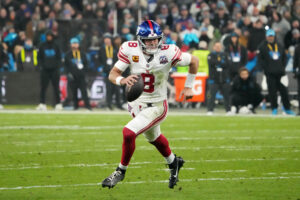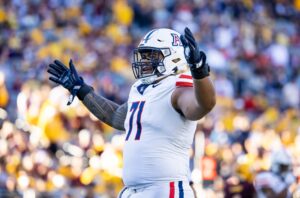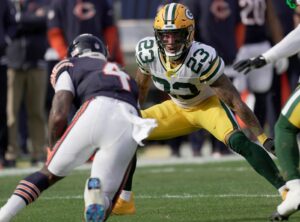Another NFL Draft is in the books. After seven rounds and 253 picks, all 32 teams now officially have their incoming class of prospects. Of course, the biggest question fans have in the aftermath of the draft is how well their favorite team did in terms of addressing their biggest positional needs.
Now it must be said that it’s difficult to give a fully accurate evaluation this early in the process. The true measure of whether or not a given draft class was hit or miss won’t be evident until these players have been on the field for a few years. But that doesn’t mean we can’t do some immediate post-draft prognostication.
Which teams aced the 2017 NFL Draft? Which ones left fans and experts scratching their heads? And which ones fell in between those two extremes? All of it will be explored in our draft grade. Here, the focus is on the NFC South and NFC West.
Last Word On Pro Football 2017 NFL Draft Grades: NFC Part Two
NFC South, by Chris Skyler
Atlanta Falcons: B
Picks
1 (26): Takkarist McKinley, edge rusher, UCLA
3 (75): Duke Riley, linebacker, LSU
4 (136): Sean Harlow, offensive guard, Oregon State
5 (149): Damontae Kazee, cornerback, San Diego State
5 (156): Brian Hill, running back, Wyoming
5 (174): Eric Saubert, tight end, Drake
Don’t let this past season’s stats fool you. Vic Beasley may have had the most sacks in 2016, but his boom-or-bust style was a staple of the Falcons pass-rush. Adding first round pick Takkarist McKinley to the opposite side of Beasley ought to improve the Falcons’ pass-rush significantly.
Duke Riley was taken with Atlanta’s second pick. While he may be too undersized to start on defense, he’s an excellent addition to their special teams. Continuing on the defensive front, Atlanta also added nickel corner Damontae Kazee to their secondary. Kazee should be able to immediately start in subpackages, even as a fourth round pick. However, the Falcons probably should have invested more in the position as their corner group was among the worst last season.
On the offense, Atlanta improved an already-good line by drafting guard Sean Harlow. They also took out an insurance policy on Devonta Freeman and/or Tevin Coleman by taking power back Brian Hill in the fifth. And finally, their last pick was used on tight end Eric Saubert, a developmental prospect that provides depth behind Austin Hooper.
The Falcons didn’t exactly wow with their picks, but they addressed needs and supplemented positions of strength with depth.
Carolina Panthers: C+
Picks
1 (8): Christian McCaffrey, running back, Stanford
2 (40): Curtis Samuel, wide receiver, Ohio State
2 (64): Taylor Moton, offensive tackle, Western Michigan
3 (77): Daeshon Hall, edge rusher, Texas A&M
5 (152): Corn Elder, cornerback, Miami (FL)
6 (192): Alex Armah, edge rusher, West Georgia
7 (233): Harrison Butker, kicker, Georgia Tech
The success of Carolina’s 2017 draft almost certainly resides on how well Christian McCaffrey plays in his first two or three seasons. Theoretically, McCaffrey adds a highly-explosive playmaker to the Panthers’ roster, but there are concerns that his skillset and size will poorly translate to the NFL. At best, Carolina found a do-it-all back that can take a lot of pressure off of Cam Newton. At worst, Carolina drafted a player that will be limited to catching passes out of the backfield for short gains.
The Panthers then added Curtis Samuel in the next round, a player with an eerily similar skillset to McCaffrey’s. Perhaps they simply want to add multiple, dynamic pass-catchers to the backfield, or maybe they don’t trust their own first round pick. Carolina’s third pick, Taylor Moton, should boost Newton’s protection – which is critical to the team’s success.
Daeshon Hall’s and Corn Elder’s additions to the roster further shore up a defense that’s recently been marred by injuries and aging players.
Finally, in lieu of Mike Tolbert’s departure from the team, Carolina added Alex Armah out of West Georgia. A rare and versatile fullback, Armah is a solid blocker and had the unusual perk of being a capable receiver.
New Orleans Saints: A-
Picks
1 (11): Marshon Lattimore, cornerback, Ohio State
1 (32): Ryan Ramczyk, offensive tackle, Wisconsin
2 (42): Marcus Williams, safety, Utah
3 (67): Alvin Kamara, running back, Tennessee
3 (76): Alex Anzalone, linebacker, Florida
3 (103): Trey Hendrickson, edge rusher, Florida Atlantic
6 (196): Al-Quadin Muhammad, edge rusher, Miami (FL)
The Saints first five picks were all in the top 100 – and all should offer immediate production in 2017. Marshon Lattimore and Marcus Williams can both be day-one starters. Lattimore may already be New Orleans’ best defensive playmaker-not- named Cameron Jordan. Williams can be Kenny Vaccaro’s other half at safety.
It’s unclear where Ryan Ramcyzk will be placed on the Saints’ offensive line, but he could replace an older Zach Strief at right tackle.
Alvin Kamara can do what Adrian Peterson can’t, and what Mark Ingram isn’t great at: catch passes out of the backfield. Kamara was rated as a second round pick, so taking him in the third was a steal.
The Saints also added a pair of linebackers in Alex Anzalone and Trey Hendrickson. Anzalone is the better of the two, and if he can stay healthy, could add a great combination of size, power, and speed to the Saints underwhelming linebacker group.
The Saints’ only pick beyond the third round, Al-Quadin Muhammad, was a low-risk- high-reward type selection in that Muhammad could be a valueable contributor should his off-field concerns be mitigated.
Tampa Bay Buccaneers: A-
Picks
1 (19): O.J. Howard, tight end, Alabama
2 (50): Justin Evans, safety, Texas A&M
3 (84): Chris Godwin, wide receiver, Penn State
3 (107): Kendell Beckwith, linebacker, LSU
5 (162): Jeremy McNichols, running back, Boise State
7 (223): Stevie Tu’ikolovatu, nose tackle, USC
The Bucs drafted a top ten talent with the 19th overall pick in O.J. Howard. In addition to being a solid blocker, Howard is a massive target for short yardage situations and compliments an increasingly fearsome and diverse receiver corps.
Justin Evans, Tampa’s second round choice, is an immediate and clear upgrade over incumbent Chris Conte. Evans was an effective and punishing safety for Texas A&M last year.
Wide receiver Chris Godwin further solidifies Tampa’s exciting group of pass-catchers, and provides an insurance policy should Mike Evans or DeSean Jackson succumb to injury in 2017. The same can be said for running back Jeremy McNichols, who could be likened to Charles Simms or Josh Huff.
Linebacker Kendell Beckwith has durability questions, but could be a good addition to Tampa’s rather average special teams. And despite his seventh round status, Stevie Tu’ikolovatu could see plenty of playing time in his rookie season as a true nose tackle. Tu’ikolovatu was rated as a fourth or fifth round player, so for Tampa to take him in the seventh is bonkers.
The Bucs would have gotten an even better grade had they invested a pick or two in their O-line, which they surprisingly didn’t address at all. Jameis Winston suffered a weekly beating in his sophomore season, so it would have been wise to address the position. However, the variety of playmakers Winston now has may make it unnecessary for Winston’s protection to be pristine.
NFC West, by Chris Bolden
Arizona Cardinals: B-
Picks
1 (13): Haason Reddick, edge rusher, Temple
2 (36): Budda Baker, safety, Washington
3 (98): Chad Williams, wide receiver, Grambling
4 (115): Dorian Johnson, offensive guard, Pittsburgh
5 (157): Will Holden, offensive tackle, Vanderbilt
5 (179): T.J. Logan, running back, North Carolina
6 (208): Rudy Ford, safety, Auburn
Arizona came out strong in their draft, addressing almost every need. Haason Reddick’s draft stock seemed to rise each week leading up to the Draft. His ability to rush the passer as well as drop back in coverage will be a huge factor for the Cardinals defense. Budda Baker was another solid addition to the defense. With Tyrann Mathieu struggling with injuries and Antoine Bethea reaching the end of his career, safety was a big need for the Cardinals.
The Chad Williams pick in the third round seems like a reach. I understand Larry Fitzgerald is on his way out and there’s a need to find his replacement. But so many really good receivers were available, like Dede Westbrook who went in the fourth round. Dorian Johnson and Will Holden will look to bolster the offensive line that allowed Carson Palmer to be hit, a league high, 117 times.
The T.J. Logan pick doesn’t make sense in the fifth round. Carson Palmer is in the last few years of his career and Brad Kaaya was sitting there waiting. Rudy Ford seems like a reach simply because speedster corner Jalen Myrick was still on the board. Safety was already addressed with Baker and the Cardinals needed a corner after a down year from Patrick Peterson.
While the Cardinals did address needs, they missed on their future quarterback, didn’t address the corner need, and I’m not convinced they drafted the right replacement for Fitzgerald.
Los Angeles Rams: B-
Picks
2 (44): Gerald Everett, tight end, South Alabama
3 (69): Cooper Kupp, wide receiver, Eastern Washington
3 (91): John Johnson, safety, Boston College
4 (117): Josh Reynolds, wide receiver, Texas A&M
4 (125): Samson Ebukam, linebacker, Eastern Washington
6 (189): Tanzel Smart, interior defensive lineman, Tulane
6 (206): Sam Rogers, fullback, Virginia Tech
7 (234): Ejuan Price, edge rusher, Pittsburgh
The Rams main focus in this draft, as it should be, was to help Jared Goff out. A true number one receiver should have been the main focus. And at the 12th pick in the second round, JuJu Smith-Schuster was available. The Rams, however, went with tight end Gerald Everett which is still addressing the need for a big target for Goff.
In the third round, Los Angeles got their receiver in Cooper Kupp. Kupp is a big bodied receiver that could prove to be a great target for Goff next season. The Rams also added another big receiver in the fourth round with Josh Reynolds. With T.J. McDonald leaving for Miami, John Johnson, taken in the third round, will likely take on the free safety position.
It’s difficult to say any team reached on a linebacker with such a deep class but Samson Ekuban seems like a reach in the fourth round when better linebackers were available. Cornerbacks Damontae Kazee and Corn Elder were also available in the fourth and the Rams missed on taking a corner all together.
Tanzel Smart, in the fifth round, and Ejuan Price, in the seventh round, help the Rams pass rush. But taking fullback Sam Rogers in the sixth round seems like a reach.
While the Rams added some weapons for Goff, they failed to draft some offensive line help to protect their quarterback. They also missed an opportunity to get one of the talented corners in this draft and two of their draft picks really fall into reach territory.
San Francisco 49ers: B+
Picks
1 (3): Solomon Thomas, edge rusher, Stanford
1 (31): Reuben Foster, linebacker, Alabama
2 (66): Ahkello Witherspoon, cornerback, Colorado
3 (104): C.J. Beathard, quarterback, Iowa
4 (121): Joe Williams, running back, Utah
5 (146): George Kittle, tight end, Iowa
5 (177): Trent Taylor, wide receiver, Louisiana Tech
6 (198): D.J. Jones, interior defensive lineman, Ole Miss
6 (202): Pita Taumoepenu, linebacker, Utah
7 (229): Adrian Colbert, cornerback, Miami (FL)
The 49ers may have won the entire Draft simply by tricking the Bears to trade down for Mitchell Trubisky. San Francisco, under new head coach Kyle Shanahan and new general manager John Lynch, had a need at almost every position. Solomon Thomas and Reuben Foster should be instant contributors for the 49ers and help boost a defense that is coming off one of its worst seasons. I’m not sure Ahkello Witherspoon was a good pick with Rasul Douglas and Fabian Moreau still on the board, though.
C.J. Beathard is the big head scratcher in this draft. Nathan Peterman, Brad Kaaya, Chad Kelly, and Joshua Dobbs were all still available. If Beathard was simply the quarterback they wanted, San Francisco could’ve easily picked him in the sixth round, maybe later.
The only need the 49ers didn’t really address was the offensive line. With there being so many needs, it’s hard to say they did, or didn’t address something but offensive line did seem like a big need for them. Trent Taylor also seems like a reach in the fifth round.
I think the 49ers are definitely better than they were coming into the draft, but they drafted the wrong quarterback and reached on a receiver. For these reasons, plus missing on an offensive lineman, they get a B+.
Seattle Seahawks: A-
2 (35): Malik McDowell, interior defensive lineman, Michigan State
2 (58): Ethan Pocic, center, LSU
3 (90): Shaquill Griffin, cornerback, Central Florida
3 (95): Delano Hill, safety, Michigan
3 (102): Nazair Jones, interior defensive lineman, North Carolina
3 (106): Amara Darboh, wide receiver, Michigan
4 (111): Tedric Thompson, safety, Colorado
6 (187): Michael Tyson, safety, Cincinnati
6 (210): Justin Senior, offensive tackle, Mississippi State
7 (226): David Moore, wide receiver, East Central (OK)
7 (249): Christopher Carson, running back, Oklahoma State
The Seahawks came into this draft with glaring needs on the offensive line. Ever since losing Max Unger, the offense hasn’t seemed to be functioning at the same level. Many experts believed this would be addressed in the first round but a player like Malik McDowell is hard to pass up. Taking Nazair Jones in the third round as well really beefs up that defensive front.
Ethan Pocic should be a great addition to the offensive line. He’s versatile and can play center as well as guard and boost the interior of that line. Shaquill Griffin and Delano Hill, both taken in the third round, will also help the secondary who struggled last season.
Amara Darboh is a receiver not many were talking about coming into the draft but could be a huge target for Russell Wilson. Xavier Woods or Rudy Ford seems like the better pick at safety in the sixth round so Michael Tyson feels like a reach.
David Moore seems like a reach as well in the seventh with Isaiah Ford and Noah Brown still on the board. With the lack of offensive line attention in this draft, the Seahawks still addressed some needs and brought in good depth. For these reasons, they get an A-.
AFC East and AFC North
AFC South and AFC West
NFC East and NFC North






